Book Reviews
Philosophical Aesthetics
Quantum Computing
Global Value Chains
Peace and Stability Operations
Autonomous Intelligent Enterprise
Artificial Intelligence

Global Value Chains
Has China Reached Its Apex?
China dominates the rare earths, green energy, and manufacturing sectors while building partnerships with the Global South. Playing the long game, China positions itself as a technological architect, reducing dependence on Western markets.

Global Value Chains
It’s Time for Companies to Adapt to Climate Change
Despite mitigation efforts, humanity prioritizes economic growth over climate limits. Bipartisan experts advocate climate adaptation as practical survival strategy. Early investments of $1.8 trillion could yield $7.1 trillion in benefits.

Global Value Chains
Geopolitical Risks on the Rise
Geopolitical instability ranks as the second-highest global risk after climate change. Supply chains face increasing politicization and disruption, requiring AI-powered real-time solutions to build enterprise resilience amid persistent geopolitical threats.Retry

Global Value Chains
The Cocoa Crisis and the Holidays
Cocoa prices surged due to weather problems in West Africa, disease, and aging trees, raising chocolate costs. Companies are increasing prices and exploring alternatives like gene editing and improved cocoa extraction techniques.
.jpg)
Personal Dispatches: Reflections on today’s society through the lens of Fortune Magazine December 1941

Global Value Chains
Earth Day 2024: Why Supply Chains Should Care
This article discusses the importance of Earth Day for businesses and their supply chains, highlighting the critical need for sustainability efforts. It explores the negative impacts of climate change on business operations and the challenges companies face in implementing environmental initiatives.

Global Value Chains
From Globalization to Glocalization
This article discusses the shift from hyper-globalization to regionalization or "glocalization" in global trade. It explores the reasons behind this trend, including geopolitical factors and supply chain resilience, while emphasizing that globalization is evolving rather than ending completely.

Global Value Chains
Moving Ahead with Net Zero Goals and Climate Adaptation
This article discusses the outcomes of COP28 and the challenges of implementing climate change mitigation strategies. It explores the high costs of fighting climate change, the necessity of adaptation, and the business case for investing in climate resilience and net-zero initiatives.

Global Value Chains
National Ag Day 2024
This article discusses National Ag Day, highlighting the importance of agriculture in the economy and daily life. It emphasizes the challenges faced by the sector, including climate change, and encourages public engagement and appreciation for agricultural professionals.



